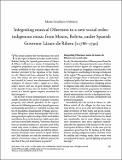Por favor, use este identificador para citar o enlazar a este item:
http://hdl.handle.net/10261/93523COMPARTIR / EXPORTAR:
 SHARE SHARE
 CORE
BASE CORE
BASE
|
|
| Visualizar otros formatos: MARC | Dublin Core | RDF | ORE | MODS | METS | DIDL | DATACITE | |

| Título: | Integrating musical Otherness in a new social order: indigenous music from Moxos, Bolivia, under Spanish Governor Lázaro de Ribera (r.1786–1792) |
Autor: | Gembero-Ustárroz, María CSIC ORCID | Palabras clave: | Indigenous music Governor Lázaro de Ribera Indians Moxos (Bolivia) Spain Post-Jesuit Latin America Spanish Enlightenment Reformism Otherness Social integration |
Fecha de publicación: | 2012 | Editor: | Oxford University Press | Citación: | Early Music (40) : 237- 251 (2012) | Resumen: | This article describes the way that music was used in the region of Moxos (in today’s north-eastern Bolivia) during the Spanish government of Lázaro de Ribera (1786–92) as a means of integrating the indigenous population into the new administrative system established in that area of the Amazon after the disorder provoked by the expulsion of the Jesuits in 1767. The musical splendour of Jesuit missions in Moxos has been covered by the musicological literature, but the period immediately after 1767 has been neglected, on the assumption that it was less important. However, many documents from archives in Spain, Bolivia and Chile show unceasing musical activity in Moxos under Governor Ribera, and the presence of music and musicians as part of the economic and administrative reforms he initiated. The article also explores how Ribera strengthened the authority of the Indian musicians to consolidate the social structures and create a new image of Moxos through many reports, drawings, musical compositions and other documents he sent to peninsular Spain. It also proposes a re-examination of nine musical pieces (1790) preserved at the Archivo General de Indias in Seville, written by Moxo Indians with indigenous texts and European musical notation, which praise the Spanish monarchs Carlos IV and María Luisa de Borbón, as well as Governor Ribera. Although these are known through several publications and recordings, their socio-political context has remained scarcely explored. These compositions, together with other documents, were sent to the Spanish king to show the advantages of the new Ribera’s Government Plan in Moxos and are a paradigmatic example of the efforts made by the governor to integrate Amerindian musical ‘Otherness’ into the colonial machinery of the Hispanic enlightened monarchy. | Versión del editor: | http://dx.doi.org/10.1093/em/cas045 http://em.oxfordjournals.org/content/40/2/237.full.pdf+html |
URI: | http://hdl.handle.net/10261/93523 | DOI: | 10.1093/em/cas045 | ISSN: | 0306-1078 | E-ISSN: | 1741-7260 |
| Aparece en las colecciones: | (IMF) Artículos |
Ficheros en este ítem:
| Fichero | Descripción | Tamaño | Formato | |
|---|---|---|---|---|
| Gembero-Ustárroz 2012. Integrating musical otherness Lázaro Ribera.pdf | 9,05 MB | Adobe PDF |  Visualizar/Abrir |
CORE Recommender
SCOPUSTM
Citations
1
checked on 22-abr-2024
WEB OF SCIENCETM
Citations
1
checked on 25-feb-2024
Page view(s)
428
checked on 24-abr-2024
Download(s)
325
checked on 24-abr-2024
Google ScholarTM
Check
Altmetric
Altmetric
NOTA: Los ítems de Digital.CSIC están protegidos por copyright, con todos los derechos reservados, a menos que se indique lo contrario.
